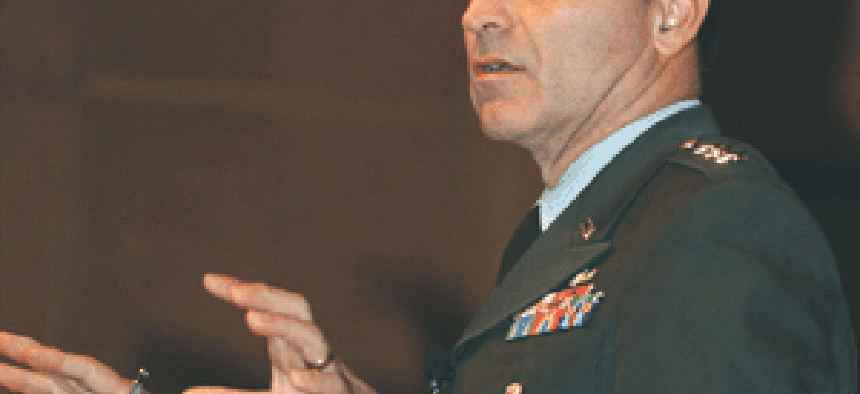Commercial satellites fly for DOD

Realizing that the next wave of government satellites will take years to develop and launch ? and even when they are launched, demand may exceed their capabilities ? the military now is reaffirming its need for commercial satellites.
Military leaders have been vocal about the government's need to become less dependent on commercial satellites for communications. Lt. Gen. Steve Boutelle, the Army's chief information officer, and Maj. Gen. Dennis Moran, vice director of command, control, communications and computer systems with the Joint Chiefs of Staff, have championed the military's need to launch its own satellites.Both have argued that the military conducts roughly 80 percent of its communications in Iraq via commercial birds, posing a unique security vulnerability.That was in the past. Today, the military appears to be singing a different tune.Realizing that the next wave of government satellites will take years to develop and launch ? and even when they are launched, demand may exceed their capabilities ? the military now is reaffirming its need for commercial satellites."The reality is that warfighters would prefer to use the military systems, because they are free and more secure," Boutelle said. "However, military systems continue to be stressed."Although commercial satellites today may be the first option for in-theater communications, military officials are not abandoning government satellites. The services are investing billions of dollars in military satellites, including the Defense Department's Transformational Satellite Communications initiative, Wideband Gapfiller, Advanced Extremely High Frequency system and the Mobile User Objective System.In addition, the Army recently issued a request for proposals for its $5 billion Worldwide Satellite Systems program. The five-year program is for turnkey commercial satellite systems and associated support services for satellite terminals, including all hardware, software, services and data to operate the terminals. Vendor bids are due by March 13, and an award is expected later this year.But those satellites will take years to develop and launch. And the Defense Department has the need now.The current military-owned and operated communications satellites were designed mostly in the 1970s and produced in the late 1970s and 1980s, and "were never intended to support the information throughput we generate and demand today," said Col. Patrick Rayermann, chief of the Army's Space and Missile Defense Division. "Back then, the Internet was a minor little network that mostly no one had heard of, and that the Defense Department used to facilitate communications between itself and certain elements of academia and industry working on various research projects."Rayermann said that industry has proven a good model in bringing speed to satellite launches."Industry is responding faster in a number of cases than the military procurement system, allowing us to lease and purchase multiband terminals and terminals that support comms-on-the-pause and comms-on-the-move," Rayermann said.The escalating need for bandwidth in desolate areas around the world has led to the military's renewed focus on commercial satellites, said Mary Ann Elliott, CEO and chairman of Arrowhead Global Solutions Inc. of Falls Church, Va.As the military continues to fight wars with fewer people and more unmanned aerial vehicles and sensor telemetry, it will continue to rely heavily on commercial satellites, she said.Two other factors favoring commercial satellites, according to Elliott, are a competition-driven reduction in bandwidth costs since Sept. 11, 2001, and a military objective to go from sensor to shooter in one minute."In the foreseeable future, the military will most definitely rely on both [commercial and government satellites], with a heavy emphasis on commercial," she said.The increase in military involvement in the aftermath of natural disasters, such as Hurricane Katrina, also has increased the demand for commercial satellites, said Amy Gwinn, director of satellite solutions and systems for TeleCommunication Systems Inc. of Annapolis, Md.The Defense Department and TeleCommunication Systems deployed the SwiftLink communications system, which includes very small aperture terminals, in New Orleans in support of the Joint Communications Support Element at MacDill Air Force Base, Tampa, Fla., a subordinate division of the Joint Forces Command.The satellites the Defense Department owns don't meet the demand and "don't have enough back-up services," Gwinn said. "The government realizes the stuff that they own is not enough."Still, the future will show the military continuing its efforts to rely less heavily on commercial satellites as the Defense Department launches its next generation of intergalactic birds, the Army's Boutelle said.Dawn Onley, a staff writer with Government Computer News, can be reached at donley@postnewsweektech.com.


"The reality is that warfighters would prefer to use the military systems, because they are free and more secure. However, military systems continue to be stressed." ?Lt. Gen. Steve Boutelle, the Army's chief information officer
David S. Spence